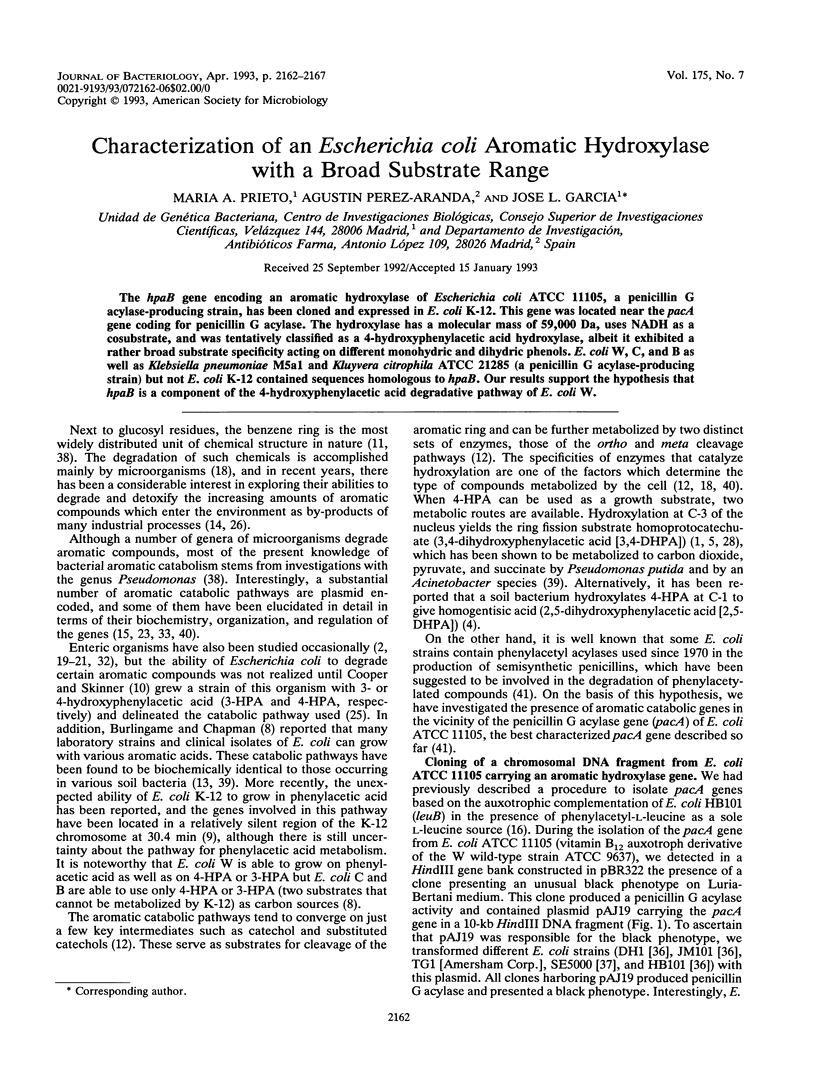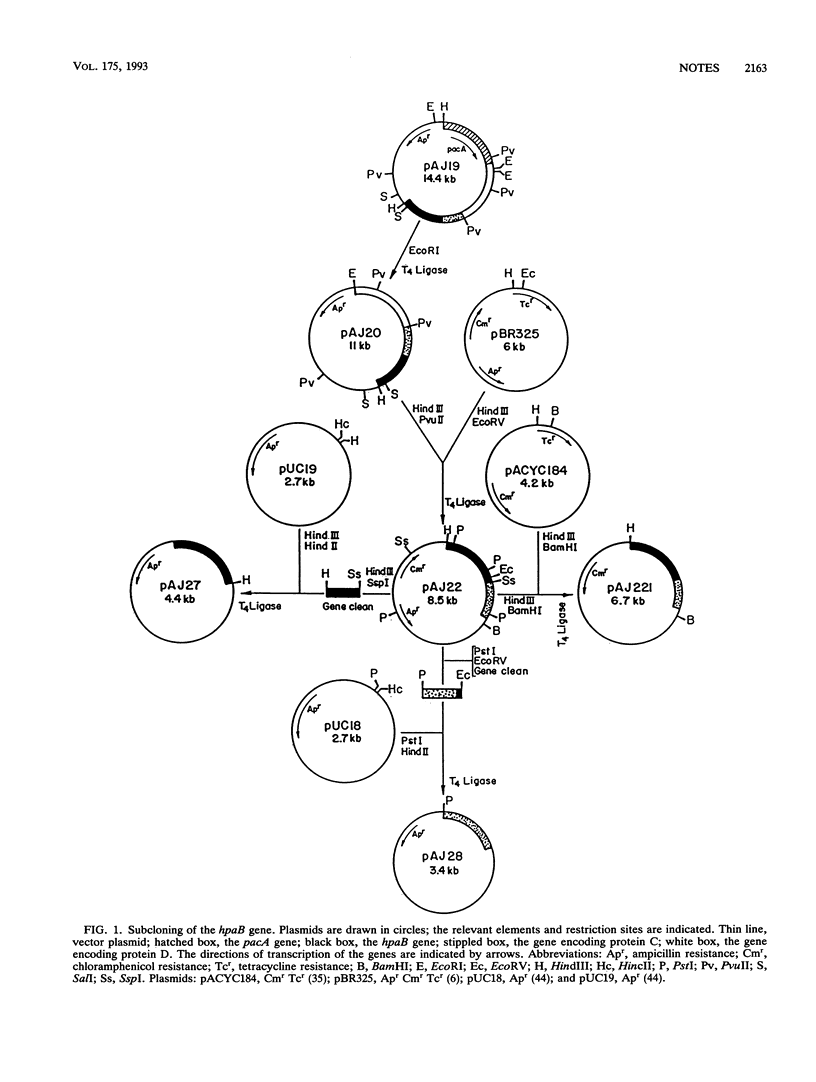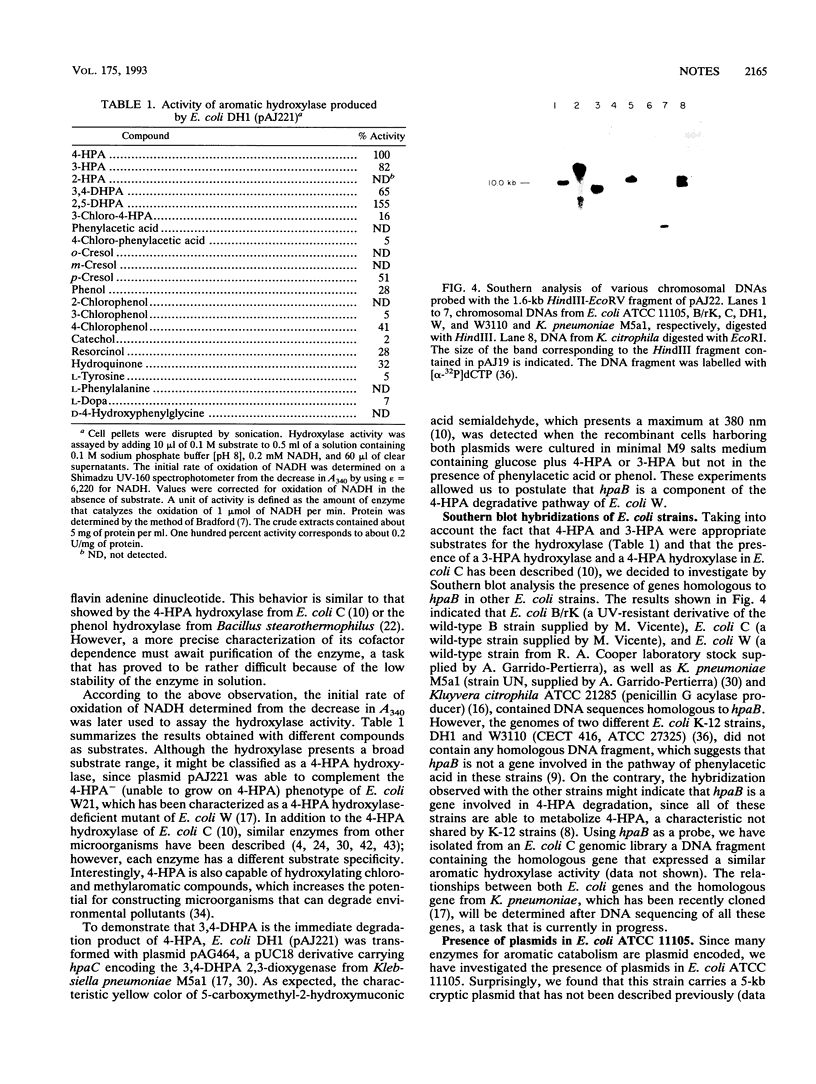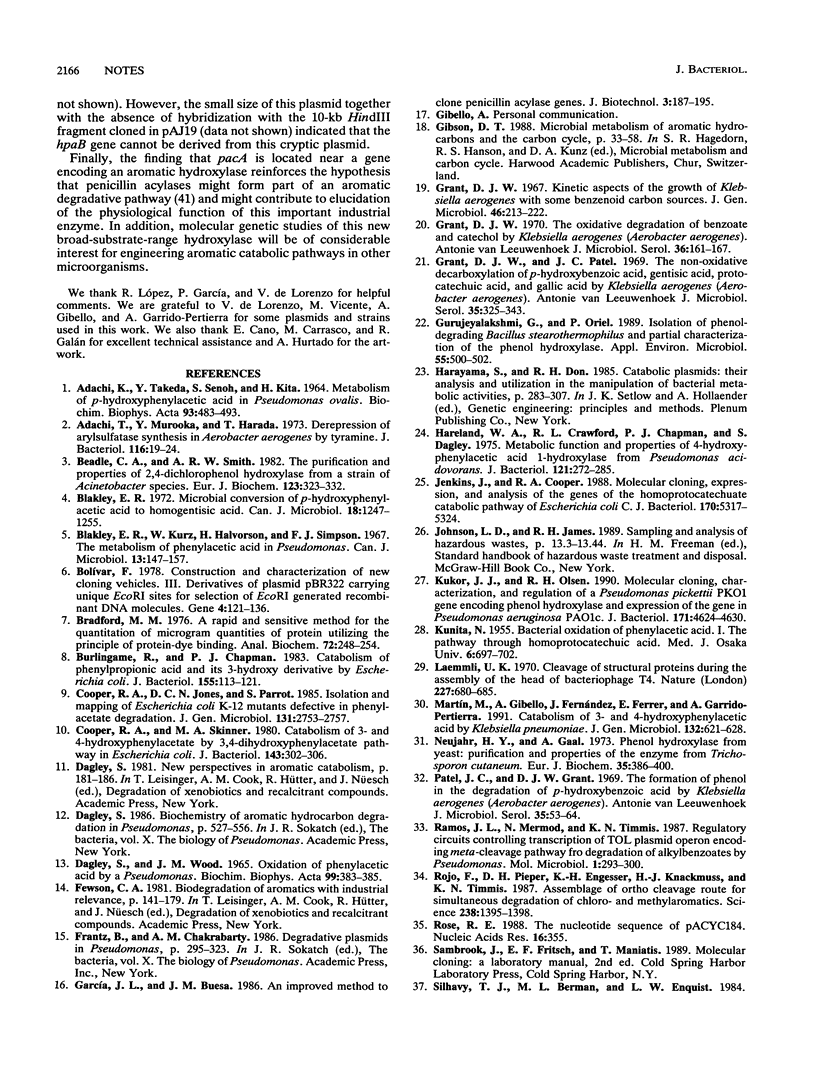Abstract
The hpaB gene encoding an aromatic hydroxylase of Escherichia coli ATCC 11105, a penicillin G acylase-producing strain, has been cloned and expressed in E. coli K-12. This gene was located near the pacA gene coding for penicillin G acylase. The hydroxylase has a molecular mass of 59,000 Da, uses NADH as a cosubstrate, and was tentatively classified as a 4-hydroxyphenylacetic acid hydroxylase, albeit it exhibited a rather broad substrate specificity acting on different monohydric and dihydric phenols. E. coli W, C, and B as well as Klebsiella pneumoniae M5a1 and Kluyvera citrophila ATCC 21285 (a penicillin G acylase-producing strain) but not E. coli K-12 contained sequences homologous to hpaB. Our results support the hypothesis that hpaB is a component of the 4-hydroxyphenylacetic acid degradative pathway of E. coli W.
Full text
PDF





Images in this article
Selected References
These references are in PubMed. This may not be the complete list of references from this article.
- ADACHI K., TAKEDA Y., SENOH S., KITA H. METABOLISM OF P-HYDROXYPHENYLACETIC ACID IN PSEUDOMONAS OVALIS. Biochim Biophys Acta. 1964 Dec 9;93:483–493. doi: 10.1016/0304-4165(64)90332-0. [DOI] [PubMed] [Google Scholar]
- Adachi T., Murooka Y., Harada T. Derepression of arylsulfatase synthesis in Aerobacter aerogenes by tyramine. J Bacteriol. 1973 Oct;116(1):19–24. doi: 10.1128/jb.116.1.19-24.1973. [DOI] [PMC free article] [PubMed] [Google Scholar]
- Beadle C. A., Smith A. R. The purification and properties of 2,4-dichlorophenol hydroxylase from a strain of Acinetobacter species. Eur J Biochem. 1982 Apr 1;123(2):323–332. doi: 10.1111/j.1432-1033.1982.tb19771.x. [DOI] [PubMed] [Google Scholar]
- Blakley E. R., Kurz W., Halvorson H., Simpson F. J. The metabolism of phenylacetic acid by a Pseudomonas. Can J Microbiol. 1967 Feb;13(2):147–157. doi: 10.1139/m67-021. [DOI] [PubMed] [Google Scholar]
- Blakley E. R. Microbial conversion of p-hydroxyphenylacetic acid to homogentisic acid. Can J Microbiol. 1972 Aug;18(8):1247–1255. doi: 10.1139/m72-193. [DOI] [PubMed] [Google Scholar]
- Bolivar F. Construction and characterization of new cloning vehicles. III. Derivatives of plasmid pBR322 carrying unique Eco RI sites for selection of Eco RI generated recombinant DNA molecules. Gene. 1978 Oct;4(2):121–136. doi: 10.1016/0378-1119(78)90025-2. [DOI] [PubMed] [Google Scholar]
- Bradford M. M. A rapid and sensitive method for the quantitation of microgram quantities of protein utilizing the principle of protein-dye binding. Anal Biochem. 1976 May 7;72:248–254. doi: 10.1016/0003-2697(76)90527-3. [DOI] [PubMed] [Google Scholar]
- Burlingame R., Chapman P. J. Catabolism of phenylpropionic acid and its 3-hydroxy derivative by Escherichia coli. J Bacteriol. 1983 Jul;155(1):113–121. doi: 10.1128/jb.155.1.113-121.1983. [DOI] [PMC free article] [PubMed] [Google Scholar]
- Cooper R. A., Jones D. C., Parrott S. Isolation and mapping of Escherichia coli K12 mutants defective in phenylacetate degradation. J Gen Microbiol. 1985 Oct;131(10):2753–2757. doi: 10.1099/00221287-131-10-2753. [DOI] [PubMed] [Google Scholar]
- Cooper R. A., Skinner M. A. Catabolism of 3- and 4-hydroxyphenylacetate by the 3,4-dihydroxyphenylacetate pathway in Escherichia coli. J Bacteriol. 1980 Jul;143(1):302–306. doi: 10.1128/jb.143.1.302-306.1980. [DOI] [PMC free article] [PubMed] [Google Scholar]
- DAGLEY S., WOOD J. M. OXIDATION OF PHENYLACETIC ACID BY A PSEUDOMONAS. Biochim Biophys Acta. 1965 May 18;99:383–385. doi: 10.1016/s0926-6593(65)80140-0. [DOI] [PubMed] [Google Scholar]
- Grant D. J. Kinetic aspects of the growth of Klebsiella aerogenes with some benzenoid carbon sources. J Gen Microbiol. 1967 Feb;46(2):213–224. doi: 10.1099/00221287-46-2-213. [DOI] [PubMed] [Google Scholar]
- Grant D. J., Patel J. C. The non-oxidative decarboxylation of p-hydroxybenzoic acid, gentisic acid, protocatechuic acid and gallic acid by Klebsiella aerogenes (Aerobacter aerogenes). Antonie Van Leeuwenhoek. 1969;35(3):325–343. doi: 10.1007/BF02219153. [DOI] [PubMed] [Google Scholar]
- Grant D. J. The oxidative degradation of benzoate and catechol by Klebsiella aerogenes (Aerobacter aerogenes). Antonie Van Leeuwenhoek. 1970;36(1):161–177. doi: 10.1007/BF02069018. [DOI] [PubMed] [Google Scholar]
- Gurujeyalakshmi G., Oriel P. Isolation of phenol-degrading Bacillus stearothermophilus and partial characterization of the phenol hydroxylase. Appl Environ Microbiol. 1989 Feb;55(2):500–502. doi: 10.1128/aem.55.2.500-502.1989. [DOI] [PMC free article] [PubMed] [Google Scholar]
- Hareland W. A., Crawford R. L., Chapman P. J., Dagley S. Metabolic function and properties of 4-hydroxyphenylacetic acid 1-hydroxylase from Pseudomonas acidovorans. J Bacteriol. 1975 Jan;121(1):272–285. doi: 10.1128/jb.121.1.272-285.1975. [DOI] [PMC free article] [PubMed] [Google Scholar]
- Jenkins J. R., Cooper R. A. Molecular cloning, expression, and analysis of the genes of the homoprotocatechuate catabolic pathway of Escherichia coli C. J Bacteriol. 1988 Nov;170(11):5317–5324. doi: 10.1128/jb.170.11.5317-5324.1988. [DOI] [PMC free article] [PubMed] [Google Scholar]
- Kukor J. J., Olsen R. H. Molecular cloning, characterization, and regulation of a Pseudomonas pickettii PKO1 gene encoding phenol hydroxylase and expression of the gene in Pseudomonas aeruginosa PAO1c. J Bacteriol. 1990 Aug;172(8):4624–4630. doi: 10.1128/jb.172.8.4624-4630.1990. [DOI] [PMC free article] [PubMed] [Google Scholar]
- Laemmli U. K. Cleavage of structural proteins during the assembly of the head of bacteriophage T4. Nature. 1970 Aug 15;227(5259):680–685. doi: 10.1038/227680a0. [DOI] [PubMed] [Google Scholar]
- Martín M., Gibello A., Fernández J., Ferrer E., Garrido-Pertierra A. Catabolism of 3- and 4-hydroxyphenylacetic acid by Klebsiella pneumoniae. J Gen Microbiol. 1991 Mar;137(3):621–628. doi: 10.1099/00221287-137-3-621. [DOI] [PubMed] [Google Scholar]
- Neujahr H. Y., Gaal A. Phenol hydroxylase from yeast. Purification and properties of the enzyme from Trichosporon cutaneum. Eur J Biochem. 1973 Jun;35(2):386–400. doi: 10.1111/j.1432-1033.1973.tb02851.x. [DOI] [PubMed] [Google Scholar]
- Patel J. C., Grant D. J. The formation of phenol in the degradation of p-hydroxybenzoic acid by Klebsiella aerogenes (Aerobacter aerogenes). Antonie Van Leeuwenhoek. 1969;35(1):53–64. doi: 10.1007/BF02219116. [DOI] [PubMed] [Google Scholar]
- Ramos J. L., Mermod N., Timmis K. N. Regulatory circuits controlling transcription of TOL plasmid operon encoding meta-cleavage pathway for degradation of alkylbenzoates by Pseudomonas. Mol Microbiol. 1987 Nov;1(3):293–300. doi: 10.1111/j.1365-2958.1987.tb01935.x. [DOI] [PubMed] [Google Scholar]
- Rojo F., Pieper D. H., Engesser K. H., Knackmuss H. J., Timmis K. N. Assemblage of ortho cleavage route for simultaneous degradation of chloro- and methylaromatics. Science. 1987 Dec 4;238(4832):1395–1398. doi: 10.1126/science.3479842. [DOI] [PubMed] [Google Scholar]
- Rose R. E. The nucleotide sequence of pACYC184. Nucleic Acids Res. 1988 Jan 11;16(1):355–355. doi: 10.1093/nar/16.1.355. [DOI] [PMC free article] [PubMed] [Google Scholar]
- Smith M. R. The biodegradation of aromatic hydrocarbons by bacteria. Biodegradation. 1990;1(2-3):191–206. doi: 10.1007/BF00058836. [DOI] [PubMed] [Google Scholar]
- Sparnins V. L., Chapman P. J., Dagley S. Bacterial degradation of 4-hydroxyphenylacetic acid and homoprotocatechuic acid. J Bacteriol. 1974 Oct;120(1):159–167. doi: 10.1128/jb.120.1.159-167.1974. [DOI] [PMC free article] [PubMed] [Google Scholar]
- Valle F., Balbás P., Merino E., Bolivar F. The role of penicillin amidases in nature and in industry. Trends Biochem Sci. 1991 Jan;16(1):36–40. doi: 10.1016/0968-0004(91)90014-m. [DOI] [PubMed] [Google Scholar]
- Van Berkel W. J., Van Den Tweel W. J. Purification and characterisation of 3-hydroxyphenylacetate 6-hydroxylase: a novel FAD-dependent monooxygenase from a Flavobacterium species. Eur J Biochem. 1991 Nov 1;201(3):585–592. doi: 10.1111/j.1432-1033.1991.tb16318.x. [DOI] [PubMed] [Google Scholar]
- Yanisch-Perron C., Vieira J., Messing J. Improved M13 phage cloning vectors and host strains: nucleotide sequences of the M13mp18 and pUC19 vectors. Gene. 1985;33(1):103–119. doi: 10.1016/0378-1119(85)90120-9. [DOI] [PubMed] [Google Scholar]




